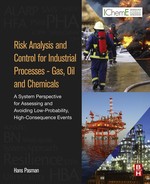Book Description
Risk Analysis and Control for Industrial Processes - Gas, Oil and Chemicalsprovides an analysis of current approaches for preventing disasters, and gives readers an overview on which methods to adopt.
The book covers safety regulations, history and trends, industrial disasters, safety problems, safety tools, and capital and operational costs versus the benefits of safety, all supporting project decision processes.
Tools covered include present day array of risk assessment, tools including HAZOP, LOPA and ORA, but also new approaches such as System-Theoretic Process Analysis (STPA), Blended HAZID, applications of Bayesian data analytics, Bayesian networks, and others. The text is supported by valuable examples to help the reader achieve a greater understanding on how to perform safety analysis, identify potential issues, and predict the likelihood they may appear.
- Presents new methods on how to identify hazards of low probability/high consequence events
- Contains information on how to develop and install safeguards against such events, with guidance on how to quantify risk and its uncertainty, and how to make economic and societal decisions about risk
- Demonstrates key concepts through the use of examples and relevant case studies
